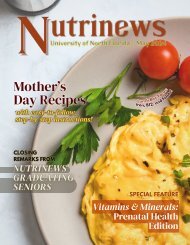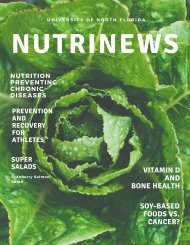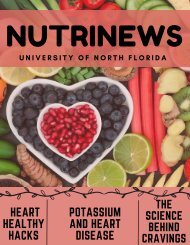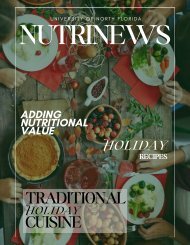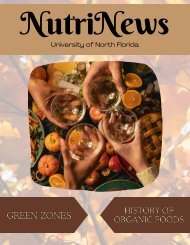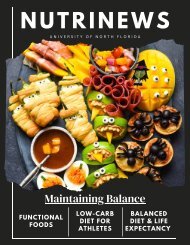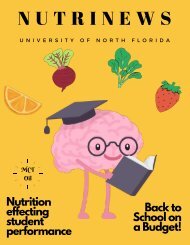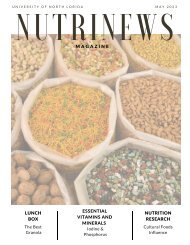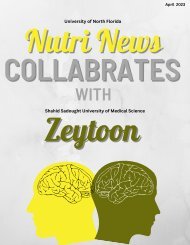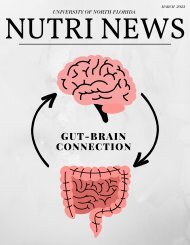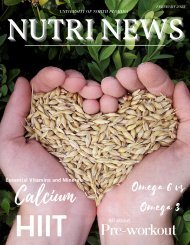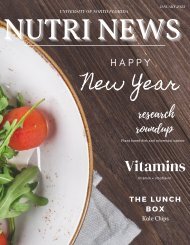April Issue
Hello Ospreys! This April issue features exciting updates on the 2021 spring graduation ceremony! We also highlight cauliflower in our Shopping in Season segment, Easy Ways to Move More and Sit Less and our Student Spotlight is on Mami Okada, who is a senior in the nutrition program. Happy reading and good luck with the rest of the semester!
Hello Ospreys!
This April issue features exciting updates on the 2021 spring graduation ceremony! We also highlight cauliflower in our Shopping in Season segment, Easy Ways to Move More and Sit Less and our Student Spotlight is on Mami Okada, who is a senior in the nutrition program.
Happy reading and good luck with the rest of the semester!
You also want an ePaper? Increase the reach of your titles
YUMPU automatically turns print PDFs into web optimized ePapers that Google loves.
NUTRI NEWS<br />
T H E D E P A R T M E N T O F N U T R I T I O N A N D<br />
D I E T E T I C S<br />
A P R I L 2 0 2 1
TABLE OF<br />
CONTENTS<br />
C O V I D C O R N E R<br />
S H O P P I N G I N S E A S O N<br />
I N T U I T I V E E A T I N G<br />
E A S Y W A Y S T O M O V E M O R E<br />
2<br />
3<br />
4<br />
7<br />
A N D S I T L E S S<br />
C O O L I T D O W N : T H E C O R R E C T<br />
10<br />
W A Y T O C O O L F O O D F O R S A F E<br />
C O N S U M P T I O N<br />
T H E L U N C H B O X<br />
S T U D E N T S P O T L I G H T :<br />
M E E T T H E S T A F F<br />
13<br />
15<br />
17<br />
1
U N F<br />
C O V I D C O R N E R<br />
After a very long semester without a break, we are nearing the<br />
end. This month, the semester will end early, and we all will get the<br />
much-needed mental rest. The end of this semester also comes<br />
with great news for our graduating seniors.<br />
a subheading<br />
The Spring 2021 graduation<br />
ceremony will be in person!<br />
Of course, COVID precautions will be taken during the celebration. Even<br />
though the details are still being hammered out, the ceremony will take place<br />
on <strong>April</strong> 17-18th with a limited number of guests attending. While following<br />
the current COVID protocols in place, the graduates will walk across the stage<br />
and have their pictures taken. Also, there will be a virtual walk-along<br />
streamed on <strong>April</strong> 17th via UNF social media platforms. This way, family and<br />
friends will still be able to celebrate their hard-working graduates while<br />
remaining socially distanced. There will also be a website launched on<br />
graduation day featuring all of the festivities, including videos, music, and<br />
speeches from the university President, students, and alumni.<br />
After the abrupt end to the Spring 2020 semester and with the unconventional<br />
graduation that came with it, this year, the hybrid celebration brings a<br />
refreshing air of normalcy that we have all been craving. Hopefully, those of us<br />
who are not graduating yet can all attend classes in person in the Fall.<br />
Remember to keep up with your COVID precautions, including social<br />
distancing, regular hand washing, and wearing your mask. We are not out of<br />
the woods yet, so let’s continue working together for the chance to return to<br />
our campus. Stay safe, Ospreys!<br />
2
S H O P P I N G I N S E A S O N :<br />
C A U L I F L O W E R<br />
By: Cameron Glover<br />
Cauliflower is a cheap, easy to locate, and versatile vegetable that can go with almost any meal<br />
you can imagine. It’s subtle flavor profile can easily be spiced to match the rest of your food as a<br />
side or you can keep it simple with salt and pepper, either way, cauliflower makes a delicious<br />
addition. This vegetable is also affordable in nearly every grocery store in various forms like<br />
riced, raw and whole, pre-chopped, and frozen. For less than $2, a bag of chopped and ready-touse<br />
cauliflower can be found which is a great way to make steamed or roasted cauliflower and<br />
even add it into a soup whole. Riced cauliflower is a low-carb rendition of rice due to a similar<br />
texture, and relatively bland flavor. Many stores sell cauliflower already “riced”, but with a food<br />
processor, it is incredibly simple to make your own.<br />
As far as nutrition goes, cauliflower is packed with a wide variety of benefits. Similar to other<br />
cruciferous vegetables, like broccoli and cabbage, it contains a significant amount of<br />
antioxidants like glucosinolates and isothiocyanates, which may be linked to a lower risk of<br />
cancer. Luckily, cauliflower does not have the pungent and off-putting smell that other<br />
vegetables in this family usually have, making it easier to swallow for some picky eaters.<br />
Cauliflower is also a great source of fiber, Vitamin C, and Vitamin K, Folate, and other important<br />
nutrients as well.<br />
Introducing cauliflower to your diet is simple because its flavor is like a blank canvas for your<br />
favorite spice blends. One of my favorite meals as a broke college student is to buy a bag of<br />
cauliflower florets, toss them with olive oil and curry powder, and roast them until they are crisp<br />
on the edges. I serve it with a protein, like chicken breast or tofu, and maybe a quick side salad.<br />
Cauliflower is also used in a lot of vegan/vegetarian products, like cauliflower nuggets,<br />
cauliflower pizza, and more. These products might be pricier, but worth trying. Adding<br />
cauliflower to your diet is easy to do with the wide variety of products on the market today.<br />
3
Intutive Eating<br />
By: Melissa Brennan<br />
Intuitive eating is a practice gaining popularity to help individuals find food<br />
freedom. Intuitive eating is characterized by eating in response to actual<br />
physiological hunger and satiety cues, rather than eating due to emotional cues.<br />
Another hallmark approach to this practice is not considering any foods offlimits,<br />
in order to further pursue food freedom. The current literature supports<br />
an inverse association between Intuitive eating (IE) and body mass index (BMI).<br />
Camilleri et al. set out to establish the association between food intake and<br />
intuitive eating in a large adult population. Their study was a web-based,<br />
prospective observational cohort that was launched in May 2009 in France with a<br />
10 year follow up. This study aimed to look at the relationship between nutrition<br />
and chronic disease risk as well as dietary behaviors and nutritional status.<br />
Participants were included in the study if they were 18 years or older, with 9,581<br />
men and 31,955 women participating. Intuitive eating (IE) was assessed in<br />
individuals by using the French version of the Intuitive Eating Scale-2, which is a<br />
valid model to assess IE status. At the start of the study, participants filled out a set<br />
of web-based questionaries that assessed dietary intake, physical activity,<br />
anthropometric data, lifestyle, socioeconomic conditions, and health status. The<br />
follow up protocol consisted of the same set of web-based questionaries<br />
administered every year for ten years. Participants reported food intake by filling<br />
out self-reported 24-hour dietary recalls. The IE Scale-2 gathered data on physical<br />
reasons to eat, reliance on hunger and satiety cues, and unconditioned permission<br />
to eat, which were all compiled with food intake data from the recalls to be<br />
assessed.<br />
4
Camilleri et al. found that women who<br />
scored higher on the IE Scale-2 for eating<br />
based off of physical cues were<br />
associated with a lower energy intake<br />
overall. A higher “physical reasons” score<br />
was also associated with lower sweet and<br />
fatty food intake in both women and<br />
men, with women also consuming fewer<br />
dairy products, meat, fish, and eggs.<br />
There was also an association between a<br />
higher “cues” score (eating when you are<br />
psychically hungry, not emotionally<br />
hungry) and a lowered intake of dairy,<br />
meat, fish, and eggs in both sexes, and<br />
lowered whole grain intake in women.<br />
Additionally, it was found that higher<br />
permission scores were associated with<br />
higher energy intake and unhealthier<br />
food choices, including less fruit,<br />
vegetable, and whole-grain intake. From<br />
this data, Camilleri et al concluded that<br />
some dimensions of intuitive eating (like<br />
eating due to physical reasons and cues)<br />
are associated with healthier dietary<br />
intakes overall. They also found that the<br />
permission dimension was associated<br />
with unhealthier dietary intakes. They<br />
further concluded that it is important to<br />
develop strategies to foster eating in<br />
response to hunger and satiety signals, as<br />
they can be associated with healthier<br />
diets and greater health status from a<br />
public health perspective.<br />
Camilleri GM, Méjean C, Bellisle F, et al. Intuitive Eating Dimensions Were Differently Associated with Food Intake in<br />
the General Population-Based NutriNet-Santé Study. J Nutr. 2017;147(1):61-69. doi:10.3945/jn.116.234088<br />
5
6
Ways to Move More and<br />
Easy<br />
Less Sit<br />
By: Tamara Marsh<br />
A sedentary lifestyle increases risks of high blood pressure, diabetes, obesity,<br />
and heart disease, deep-vein thrombosis (i.e. blood clots within deep veins),<br />
and abnormal cholesterol levels. Sitting for long periods even if you are<br />
moderately active tightens the hamstring muscles and hip flexors and stiffens<br />
joints. Excessively tight hip flexors and hamstrings lead to walking and<br />
balancing difficulties, lower back pain, and knee stiffness.1,2<br />
In one study, researchers found high levels of the total amount of daily time of<br />
sitting are linked to increased chances of heart disease and diabetes outside<br />
of the physical activity. They concluded the total amount of sitting on a daily<br />
basis should be reduced.3<br />
In another study, researchers found when sedentary type 2 diabetes subjects<br />
shortened their sitting time and replaced it with moderate physical activity and<br />
standing, they experienced a positive change in their post-meal metabolic<br />
levels. They concluded breaking up sitting time has a positive effect on<br />
metabolic levels. However, the physical activity type, intensity, and frequency<br />
to offset the harmful effects of prolonged sitting will vary from person to<br />
person. Further studies are needed to determine the physical activity<br />
procedure (type, volume, frequency, and intensity) to break prolonged time<br />
spent sitting in various populations.4<br />
The best way to combat the risk of prolonged sitting is to reduce total sitting<br />
less and move more.<br />
7<br />
time and take standing or physical activity breaks. Here are some ways to sit
C T I V I T I E S W I T H W A L K I N G<br />
A<br />
and talk when on the<br />
Walk<br />
1 R E P L A C E S I T T I N G<br />
R E P L A C E S I T T I N G A C T I V I T I E S<br />
W I T H S T A N D I N G<br />
2<br />
C H O O S E H O B B I E S T H A T<br />
A L L O W Y O U T O B E<br />
3<br />
O N V E N I E N T O P T I O N S<br />
C<br />
the stairs instead of<br />
Take<br />
4 O P T F O R T H E L E S S<br />
1.Edward Laskowski. Sitting risks: how harmful is too much sitting? MayoClinic.org. Accessed February 27, 2021. https://www.mayoclinic.org/healthy-lifestyle/adult-health/expert-answers/sitting/faq-20058005.<br />
2.Harvard Health Publishing. The dangers of sitting. Health.Harvard.edu. Accessed February 27, 2021. https://www.health.harvard.edu/pain/the-dangers-of-sitting.<br />
3. Bailey DP, Hewson DJ, Champion RB, Sayegh SM. Sitting time and risk of cardiovascular disease and diabetes: a systematic review and meta-analysis. Am J Prev Med. 2019;(3):408-416. doi:10.1016/j.amepre.2019.04.015.<br />
4. Benatti F, Ried-Larsen M. The effects of breaking up prolonged sitting time: a review of experimental studies. Med Science Sports Exerc. 2015;47(10):2053-2061. doi:10.1249/MSS.0000000000000654.<br />
P H Y S I C A L L Y A C T I V E<br />
Play a sport (eg. soccer,<br />
phone or when hanging out<br />
with friends<br />
tennis,<br />
Walk into a store instead of<br />
baseball, etc.,)<br />
Dance, garden, hike, bike<br />
using a drive-thru<br />
Walk to your destination<br />
Ski, Snowboard<br />
Swim, Scuba dive. rock<br />
instead of using public<br />
climb<br />
transportation or a car<br />
Stand when commuting on public<br />
using the elevators<br />
transportation, while using a<br />
Park far away from your<br />
computer, during commercial breaks<br />
destination<br />
when watching a television show,<br />
Get off one or two stops<br />
while studying, reading, or using a<br />
before your destination and<br />
phone<br />
walk the rest of the way!<br />
8
9
12
Student Spotlight:<br />
Mami Okada<br />
Hey everyone! Our student spotlight for<br />
this month is Mami Okada. Mami was born<br />
in Japan and has lived in Florida for five<br />
years. She is a senior in the Nutrition and<br />
Dietetics program and works at UNF’s<br />
Ogier Garden as a student farmer. Read<br />
along to learn more about Mami and her<br />
time as an undergrad at the University of<br />
North Florida.<br />
KG: What inspired you to pursue a major in Nutrition and Dietetics?<br />
MO: I was studying Sociology for two years before Nutrition. While I was<br />
studying Sociology, I got to learn about many food-related problems<br />
happening around the world such as hunger, food insecurity, and food<br />
waste. Since then, I have always wanted to contribute to solving those<br />
problems, therefore I decided to study nutrition. Besides my nutrition major,<br />
I have two minors: Food Systems & Sustainability and Environmental<br />
Studies. Sustainability is something I am really passionate about.<br />
KG: What activities or hobbies do you enjoy doing outside of school?<br />
MO: When I have free time I like to cook, exercise, and learn new languages<br />
(currently Spanish and French). I also love to travel both domestically and<br />
internationally and try new foods. Since I have not been able to travel for a<br />
long time because of the pandemic, I have been enjoying trying different<br />
cuisines within the Jacksonville area. The most recent one I tried was<br />
Portuguese cuisine.<br />
KG: What advice do you have for upcoming students entering the<br />
nutrition program?<br />
MO: If you are interested in food sustainability, I highly recommend<br />
minoring in Food Systems & Sustainability. Also, volunteering at the UNF<br />
Ogier gardens and Meals on Wings is a great way to get involved!<br />
15
Meet The Staff<br />
Emily Henley<br />
Editor in Chief<br />
Anna Waterman<br />
Co Editor in Chief<br />
Aishwarya Patel<br />
Head Publisher<br />
Dr. Alireza Jahan-<br />
Mihan<br />
Faculty Advisor<br />
Contact Us :<br />
UNFNutriNews @gmail.com<br />
17
Meet The Staff<br />
Kyla Cooper<br />
Editor<br />
Dalila Mumic<br />
Editor<br />
Allison Barfieild<br />
Editor<br />
Anita Diaz<br />
Public Relations Manager<br />
Contact us :<br />
UNFNutriNews @gmail.com<br />
18
Meet The Staff<br />
Ronesia Willson<br />
Public Relations<br />
Website Manager<br />
Maris Meza<br />
Publisher<br />
Anna McQueen<br />
Publisher<br />
Cristina Reyes<br />
Publisher<br />
Contact Us :<br />
UNFNutriNews @gmail.com<br />
19
Meet The Staff<br />
Atalia Vazquez<br />
Treasurer<br />
Kathryn Griffiths<br />
Flyer Designer<br />
Payton Turner<br />
Photographer<br />
Contact Us :<br />
UNFNutriNews @gmail.com<br />
20




